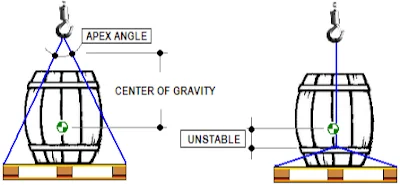Introduction
In the realm of engineering and construction, mastering the principles of lifting and rigging is paramount. One crucial concept within this domain is the center of gravity (COG), which plays a pivotal role in determining the stability and balance of any object being lifted or rigged. In this comprehensive guide, we delve deep into the intricacies of the center of gravity, its calculation, significance, and practical applications in lifting and rigging operations.
I. Understanding the Center of Gravity (COG)
A. Defining the Center of Gravity
At its core, the center of gravity refers to the point within an object where its entire weight is concentrated. It is the theoretical point where the entire mass of the object can be assumed to be concentrated for the purpose of calculating its behavior in various conditions.
B. Calculation of the Center of Gravity
The center of gravity of an object can be calculated using mathematical formulas based on its shape, mass distribution, and orientation. For a uniform object with symmetrical shape and mass distribution, the center of gravity typically coincides with its geometric center. However, for irregularly shaped objects or those with non-uniform density, determining the center of gravity requires more sophisticated calculations.
The general formula for calculating the center of gravity of an object with discrete masses is:
Where:
xˉ represents the x-coordinate of the center of gravity,
mi represents the mass of each component,
xi represents the x-coordinate of each component's center of gravity, and
n represents the total number of components.
C. Significance of the Center of Gravity in Lifting and Rigging
In lifting and rigging operations, understanding the center of gravity is crucial for maintaining stability and preventing accidents. When lifting an object, the rigging equipment must be positioned in such a way that the center of gravity remains within the base of support to ensure balance and prevent tipping or overturning.
D. Practical Applications
The knowledge of the center of gravity finds extensive applications across various industries, including construction, manufacturing, and transportation. From designing crane configurations to securing cargo on ships, engineers rely on accurate calculations of the center of gravity to ensure safety and efficiency in lifting and rigging operations.
II. Center of Gravity Calculation in Lifting and Rigging
A. Determining the Center of Gravity of Load
When lifting a load, determining its center of gravity is paramount for selecting the appropriate rigging configuration and calculating the required counterweights. This involves analyzing the load's shape, weight distribution, and any asymmetrical factors that may affect its stability.
B. Rigging Configurations for Stability
Based on the calculated center of gravity of the load, engineers can determine the optimal rigging configuration to maintain stability during lifting. This may involve adjusting the sling angles, adding counterweights, or using specialized lifting attachments to ensure that the center of gravity remains within the safe zone.
C. Safety Considerations
Failure to accurately assess the center of gravity and implement appropriate rigging measures can result in catastrophic accidents, including load shifts, equipment failures, and structural damage. Therefore, rigorous safety protocols and thorough risk assessments are essential components of any lifting and rigging operation.
III. Conclusion
In conclusion, mastering the concept of the center of gravity is indispensable for success in lifting and rigging operations. By understanding how to calculate and manipulate the center of gravity, engineers can ensure the safety, stability, and efficiency of lifting tasks across diverse industrial settings. From construction sites to manufacturing facilities, the principles of center of gravity remain fundamental in the world of engineering and construction.



Post a Comment for "The Science of Lifting and Rigging: Understanding the Center of Gravity"